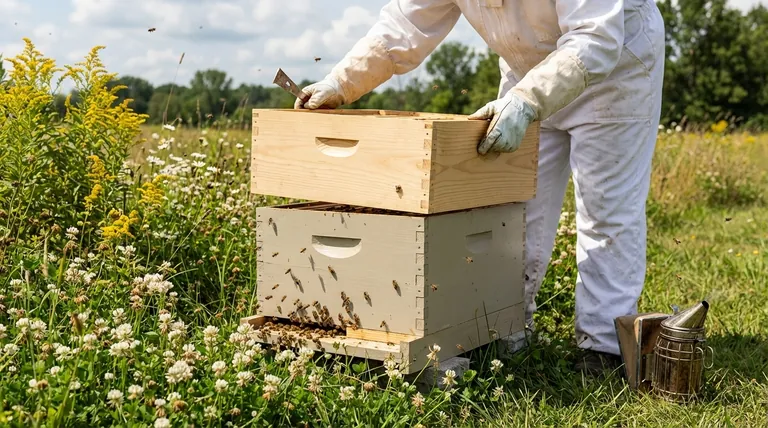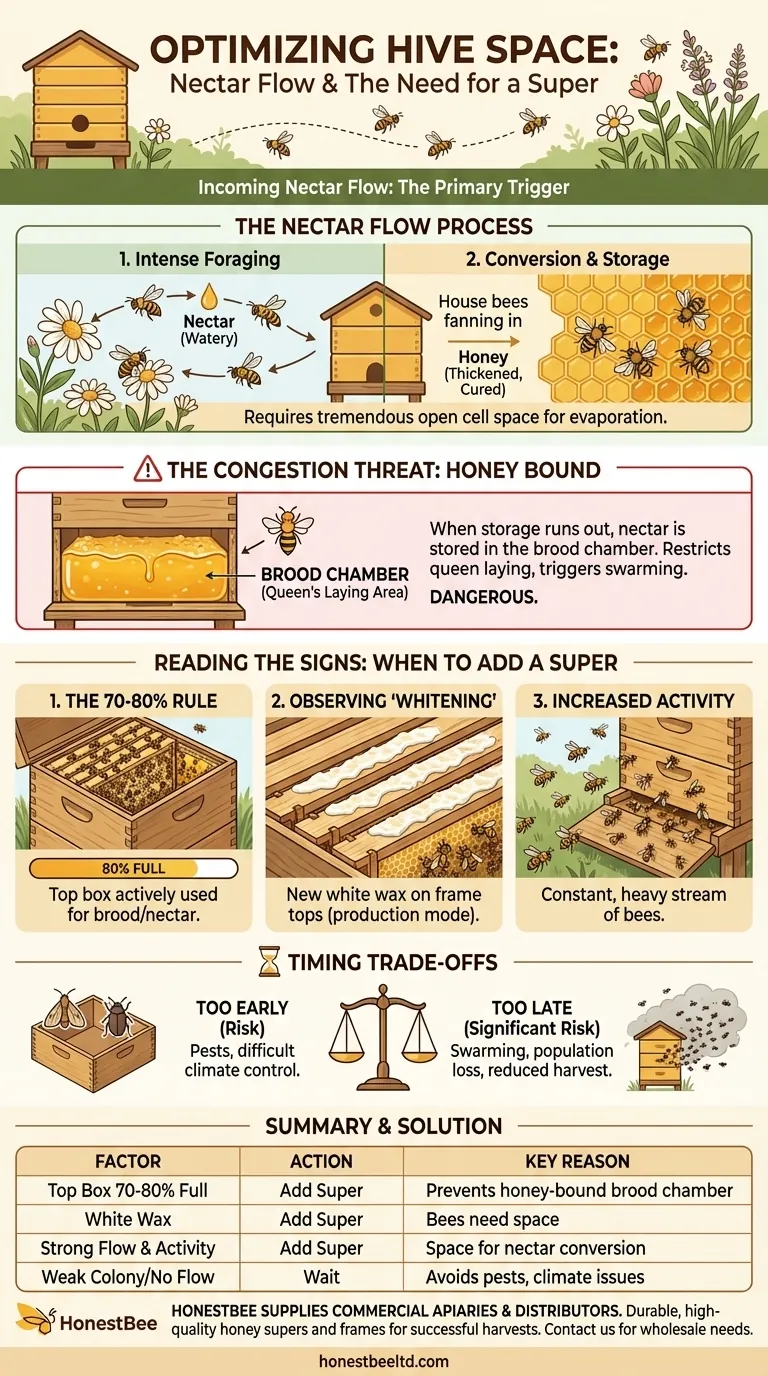In short, a strong nectar flow is the primary trigger for adding a honey super. During this period of intense foraging, the bee colony’s primary goal is to collect and store as much nectar as possible. Providing a super gives them the necessary space to store these resources without clogging their living and breeding areas, which is critical for the health and productivity of the hive.
A nectar flow creates an urgent need for space within the hive. Your job as the beekeeper is to provide that space at the right time to prevent the colony from becoming congested, which can halt brood production and trigger swarming.

The Connection Between Nectar and Space
What is a Nectar Flow?
A nectar flow is the specific time of year when major nectar-producing plants in your area are in full bloom. During this period, bees work relentlessly, flying thousands of miles as a colony to gather this sugary liquid.
The Bee's Conversion Process
Nectar is not honey. When foragers return to the hive, they pass the thin, watery nectar to house bees. These bees add enzymes and deposit the nectar into honeycomb cells, where they fan it with their wings to evaporate moisture until it thickens into honey.
This process requires a tremendous amount of open cell space—far more than the final volume of cured honey.
Why Congestion is a Critical Threat
If bees run out of storage space in the upper boxes, they will begin to store nectar in the brood chamber—the area where the queen lays her eggs.
This condition, known as being "honey bound," is dangerous. It severely restricts the queen's ability to lay, which shrinks the future population of the colony and is a primary trigger for the hive to swarm.
Reading the Signs: When to Add a Super
The key to successful timing is observation. A nectar flow alone is not the only signal; the colony must also be ready for the extra space.
The 70-80% Rule
This is the most reliable guideline. Open your hive and inspect the top-most box. If the bees have built out comb and are actively using 7-8 of the 10 frames for brood, pollen, or nectar, it is time to add a super.
Observing "Whitening"
When bees are building new comb, they secrete fresh, white beeswax. Look for this "whitening" along the top bars of the frames in the uppermost box. This is a definitive sign that the bees are in production mode and ready for more construction space.
Increased Hive Activity
During a strong flow, the entrance of the hive will be incredibly busy. You will see a constant, heavy stream of bees flying in and out. Bees returning to the hive will often fly low and appear heavy as they land.
Understanding the Trade-offs
Timing is a balance. Adding a super too early or too late both come with consequences.
The Risk of Adding a Super Too Early
If you add a super before the colony is strong enough to occupy it, they will struggle to patrol and defend the extra space. This creates an ideal breeding ground for pests like wax moths and small hive beetles.
The excess volume also makes it harder for the bees to regulate temperature and humidity within the hive, forcing them to expend extra energy.
The Consequence of Adding a Super Too Late
This is the more significant error. By waiting too long, you risk creating a honey-bound brood chamber, which can trigger a swarm.
When a hive swarms, you lose the old queen and roughly half of your bees. This dramatically sets back the colony's population and its honey-producing potential for the rest of the season.
Making the Right Decision for Your Hive
Your decision to add a super should be based on a combination of observing the environment (is there a nectar flow?) and observing the colony itself (are they ready for space?).
- If your primary focus is preventing a swarm: Add a super as soon as the top box reaches 70% capacity during a flow to ensure the queen always has ample laying space.
- If your primary focus is maximizing the honey harvest: Add supers proactively during a strong flow, sometimes even before the previous one is 100% full, to ensure the bees never stop gathering nectar due to a lack of storage.
- If you are a new beekeeper and feel unsure: It is almost always better to add a super a bit early than to add one too late. The risks of pests in an empty box are more manageable than the risk of losing half your colony to a swarm.
Ultimately, managing supers is about partnering with your bees, providing them with the resources and space they need precisely when they need them to thrive.
Summary Table:
| Decision Factor | Action | Key Reason |
|---|---|---|
| Top Box 70-80% Full | Add a Super | Prevents brood chamber from becoming honey-bound, which triggers swarming. |
| Observing 'Whitening' Wax | Add a Super | Bees are actively building comb and need more space for nectar storage. |
| Strong Nectar Flow & High Activity | Add a Super | Provides essential space for converting nectar to honey without congestion. |
| Colony is Weak or No Nectar Flow | Wait | Adding space too early can invite pests and make climate control difficult for bees. |
Ensure your apiary is equipped for every nectar flow. A well-timed super is key to hive health and a successful harvest. HONESTBEE supplies durable, high-quality beekeeping supplies and equipment—including honey supers and frames—to commercial apiaries and beekeeping equipment distributors through our wholesale-focused operations.
Let us help you build a more productive and profitable operation. Contact HONESTBEE today to discuss your specific needs and explore our full product catalog.
Visual Guide

Related Products
- Langstroth Honey Bee Box Hive Boxes for Different Depths
- Professional 500g Sectional Comb Honey Frame System for Beekeeping
- Economy Small Scale Honey Dryer Dehumidifier Thickening Machine
- High-Efficiency Diamond Maze Bee Escape for Clearing Supers
- Commercial 48-Frame Stainless Steel Honey Extractor
People Also Ask
- What is the purpose of the boxes in a Langstroth hive? A Guide to Modular Beekeeping Success
- How does a hive box work? A Guide to the Langstroth Hive System for Beekeepers
- What factors should beekeepers consider when choosing between wooden and polystyrene hives? Maximize Bee Health and Honey Production
- What are the sizes of supers available in a standard hive? A Guide to Deep, Medium, and Shallow Boxes
- How should hive boxes be aligned after reassembly? Ensure a Perfect Seal for Hive Health



















